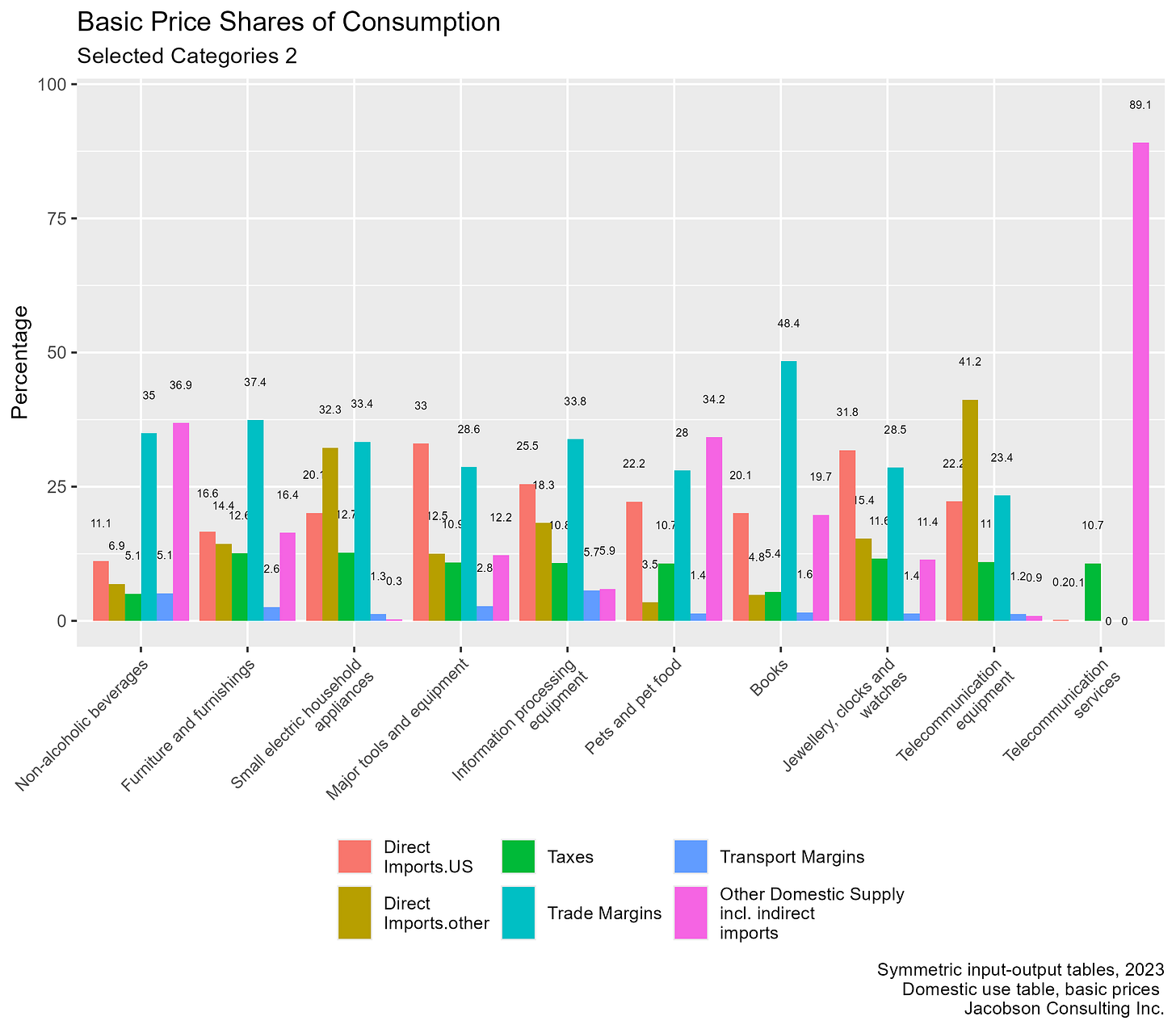Consumption Imports and Margins Methodology
Canada is a small open economy. Trade is important both for exports and imports. Personal consumption includes goods of varying characteristics and services. This study focuses on how consumption goods and services reach consumers. The goods and services are sourced from domestic production and imports. Imports are the channel of influence for foreign prices to our CPI.
The trade margins are produced domestically dominantly by wholesale and retail producers but also by other producers selling to consumers. The transport margins are associated with getting the goods to consumers. They are largely produced by the trucking and logistics sectors, but pipelines are used to get natural gas to end users.
The important messages are:
· Imports are important in many goods categories,
· Trade margins are often the most significant domestic component,
· Taxes are always significant for personal consumption.
The charts in this report show the shares of the components in terms of the price paid by consumers, the purchasers price. Generally, durable goods have the highest import share followed by semi-durables. The charts and data show that the range is quite broad. New cars and trucks have import shares exceeding 60% and the tax margin exceeds any domestic supply. In contrast, used cars are supplied from domestic sources. Non-US new car imports exceed those from the US.
The data in this report have been updated to the 2023 version of the IO data tables.The Daily announcement of its availability is at this link. https://www150.statcan.gc.ca/n1/daily-quotidien/250414/dq250414e-eng.htm
This report presents the data to include imports from the rest of the world separate from the US.
The imports shown are characterized as direct imports, valued on a CIF basis (cost, insurance, and freight) to make them comparable to domestic production. These imports are not used for further production in Canada but go directly to consumers. Domestic production will likely embody some indirect imports, but these are not measured in this analysis. In this version of the report, direct imports have been partitioned into those from the US and from other countries.
Generally, services are produced domestically. However, some are imputed. Roughly 40% of total services is accounted for by paid and imputed rent. The latter is the rent that homeowners pay themselves to account for the services provided by their house. It is not directly associated with market wages or other market transactions.
The data in this study are from Input-Output component of the Canadian Economic Accounts provides structured benchmarked detail for economic transactions. The symmetric version of the data can be used to provide a useful partition of the personal expenditure categories of final demand into the portion obtained from domestic suppliers, imports, taxes, and the margins supplied by the trade and transportation sectors. The latter margins add on to the basic supply from domestic and import suppliers to get the goods to consumers.
This shows the aggregate distribution of consumer expenditure at purchasers prices.
The initial supply from domestic and foreign suppliers is valued in basic prices. These can be thought of as “factory gate” prices for domestic products and “landed” prices for imports. Combined with margins and taxes, the resulting aggregates are valued at purchaser’s prices, the price paid by final consumers.
The trade and transport margins are allocated in the final IO data tables to the sectors which produce them and are the main output of these sectors.
The next chart shows a further disaggregation to the main high level consumption aggregates.
As would be expected, services are largely supply domestically. Semi-durable goods have the largest trade margins because of the nature of the product. There are no trade margins for services because services are delivered by the producer. The domestic supply share for semi-durables such as clothing is relatively low.
The initial charts in the detailed report show expenditure on selected commodities partitioned into shares of purchaser-price consumption for imports, taxes, trade, and transportation margins as well as the residual supplied by domestic producers. Only a few of the 104 categories of consumption are shown.
Some key categories are below.
In the initial two charts, the last set of bars reflects the shares for the total of personal consumption. The high “other domestic” share reflects the fact that many services have no import component and negligible tax and other margins. Such services include the impute rent on owner occupied dwellings. Other services such as telecommunications services (bottom plot) have almost no import component.
Telecommunications services is an example of a highly administered product with barriers to entry. More importantly, significant investment is usually associated with an increase in quality and price. This suggests that quality adjustment is required to properly reflect the inflation impact.
Additional charts are provided for each of the main consumption aggregates: Durables, Semi-Durables and Non-Durables.
The broad points in this post are that foreign prices, and supply, are important for a small open economy because of the key role played by direct imports. Domestic supply is the key source for services.








